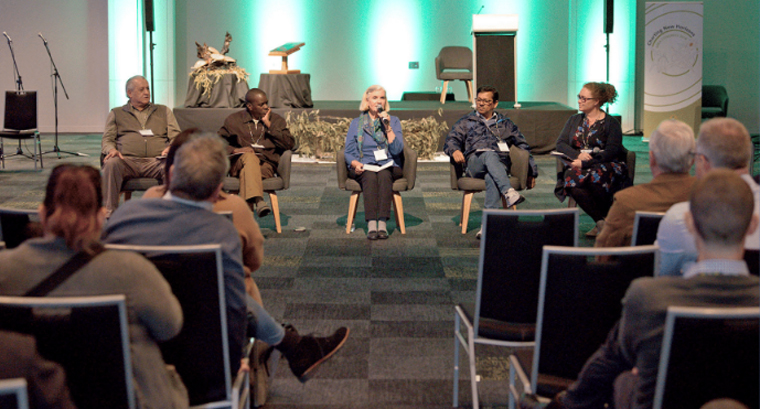Contributed by Maureen Kiers, Co-Director
ERCBNA Office of Educational Services

Maureen Kiers with the microphone.
Last fall I was invited by Wayne Tinsey, Executive Director and Brian Garrone, Director of Communication and Global Partnership for Edmund Rice Education Australia, to attend the EREA Congress this September. The Congress was held at the Melbourne Park Function Centre (next to the Rod Laver Tennis Center). It brought together about 250 “members of the school communities and representatives from Edmund Rice schools internationally, members of the leadership teams of the Christian Brothers, leaders in Catholic education and other partners across the Church and society.” Besides myself, the international guests included representatives from India, Ireland, Kenya, South Africa, Tanzania and Zambia. Brothers Hugh O’Neill and Julian McDonald represented the Congregational Leadership Team.
The purpose of the Congress was to “bring the national community together – listen, reflect, experience, provide our voice, model innovative ways of interacting, learning and celebrating, and ultimately determine new horizons for our family of schools.” There was clearly a concern about the indigenous peoples of Australia and the themes of inclusion and reparation were repeated throughout our time there.
The theme of the Congress, Charting New Horizons, included talks on the four touchstones of EREA: Gospel Spirituality, Justice and Solidarity, Inclusive Community and Liberating Education. Guest speakers in these areas included Senator Patrick Dodson, the only indigenous person with that title and called the Father of Reconciliation; Fr. Frank Brennan, S.J., the CEO of Catholic Social Service Services Australia; Kirsty Sword-Gusmao, Goodwill Ambassador for Education and former First Lady of Timor-Leste; Emma Alberici, Chief Economics Correspondent for ABC (Australia). Leoni Degenhardt, Emeritus Dean of the AIS Leadership Centre, served as the Facilitator and Fr. Kevin Hennessey, a Passionist priest, was the Congress Liturgical Guide.

The day before the Congress opened,the international representatives met at the EREA Centre. Several people had been to the Chapter Meeting in Nairobi in 2014,so there was follow-up on the subject of Edmund Rice Education Beyond Borders (EREBB). Topics discussed were developing identity, i.e., having schools commit to leading others in EREBB;and sharing identity resources to do more internationally to help those schools with fewer resources. Also proposed was the possibility of schools “twinning”, virtually or otherwise, so that partnerships maybe established and resources shared. It was noted that world-wide,the Edmund Rice schools have a resource base of nearly 20,000 teachers. One item on the minds of several of the participants was the education in the charism of Edmund Rice of new school leaders. It was also suggested that each school appoint a staff member to be the communicator to EREBB.
Part of our work as international representatives was to participate in a panel discussion covering our experiences of an Edmund Rice education from our cultural perspectives,and the importance of developing global links between our schools. It was an honor to be part of this discussion and opened Maureen Kiers -3-my eyes to the realities of schools in countries that do not have the same resources that we in North America have.
What a privilege to have participated in this Congress –the hospitable people, the wonderful food, the stimulating conversations, the beautiful weather, the opportunity to visit that part of the world-are all something I will not forget. Recognizing that we are part of a vibrant and diverse international community and using that strength should be a great step in moving all of our schools forward.